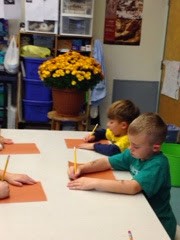Students trooped to the banks of the Hudson to participate in Hudson River Snapshot Day, despite the cold and rainy weather. Observational drawing, one component of the data gathering, happened back at school right after we returned where it was dry and warm, but recollections were still fresh. The students discussed what they had noticed; colors, shapes, tree and rock formations. Working from this recent memory they then drew pictures.
 |
| Recollections from the river |
 |
| Parker students and Spanish visitors drawing |






















































